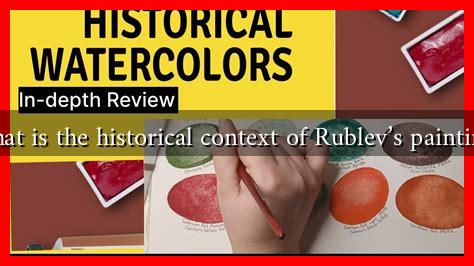-
Table of Contents
The Historical Context of Rublev’s Paintings
Andrei Rublev, a 15th-century Russian icon painter, is often regarded as one of the greatest artists in the history of Russian art. His works, characterized by their spiritual depth and exquisite beauty, reflect the complex historical and cultural milieu of medieval Russia. Understanding the historical context of Rublev’s paintings is essential to appreciate their significance and enduring legacy.
The Rise of Orthodox Christianity in Russia
Rublev’s artistic career unfolded during a pivotal time in Russian history, marked by the consolidation of Orthodox Christianity as a central element of Russian identity. Following the Christianization of Kievan Rus’ in 988, the Orthodox Church played a crucial role in shaping the cultural landscape of the region. By the time Rublev was active, the church had established itself as a powerful institution, influencing art, literature, and politics.
- Religious Significance: Rublev’s paintings were primarily religious in nature, serving as icons that facilitated worship and spiritual reflection.
- Iconography: His works often depicted biblical scenes and saints, employing a visual language that conveyed theological concepts.
- Patronage: The church was a significant patron of the arts, commissioning works that would inspire devotion among the faithful.
The Mongol Influence and the Rise of Moscow
The historical backdrop of Rublev’s life was also shaped by the Mongol invasion of the 13th century, which led to the fragmentation of Kievan Rus’ and the rise of the Grand Duchy of Moscow.
. This period of Mongol rule, known as the “Tatar Yoke,” profoundly affected Russian society and culture.
- Isolation and Resilience: The Mongol dominance isolated Russian principalities, fostering a sense of resilience and a desire for cultural revival.
- Moscow as a Cultural Center: By the 15th century, Moscow emerged as a cultural and political center, where Rublev created many of his masterpieces.
- Artistic Synthesis: The interaction between Byzantine and local traditions during this period led to a unique synthesis in Rublev’s style.
Rublev’s Iconic Works
Rublev’s most famous work, “The Trinity,” exemplifies his mastery of iconography and his ability to convey profound spiritual truths. Painted around 1410, this icon depicts the three angels who visited Abraham, symbolizing the Holy Trinity. The composition is notable for its harmonious colors and serene expressions, inviting viewers into a contemplative space.
- Color Symbolism: Rublev employed a rich palette, where each color held symbolic meaning, enhancing the spiritual narrative.
- Spatial Harmony: The arrangement of figures creates a sense of unity and balance, reflecting the theological concept of the Trinity.
- Influence on Later Artists: “The Trinity” has inspired countless artists and remains a cornerstone of Orthodox iconography.
The Legacy of Rublev’s Art
Rublev’s contributions to Russian art extend beyond his lifetime. His works became a touchstone for subsequent generations of artists and played a crucial role in the development of Russian icon painting. The revival of interest in Rublev’s art during the 19th century, particularly among the Russian avant-garde, further solidified his status as a national icon.
- National Identity: Rublev’s art is often seen as a symbol of Russian spiritual and cultural identity.
- Modern Interpretations: Contemporary artists continue to draw inspiration from Rublev’s techniques and themes, bridging the past with the present.
- Preservation Efforts: Institutions like the Tretyakov Gallery in Moscow house many of Rublev’s works, ensuring their preservation for future generations.
Conclusion
Andrei Rublev’s paintings are not merely artistic expressions; they are profound reflections of the historical, cultural, and spiritual currents of his time. From the rise of Orthodox Christianity to the impact of the Mongol invasion and the emergence of Moscow as a cultural hub, Rublev’s work encapsulates a rich tapestry of influences. His legacy endures, inspiring both reverence and scholarly inquiry, making him a pivotal figure in the history of art. Understanding the historical context of Rublev’s paintings allows us to appreciate their depth and significance, ensuring that his contributions to art and spirituality continue to resonate through the ages.
For further reading on Rublev’s life and works, you can explore resources such as the Tretyakov Gallery.





